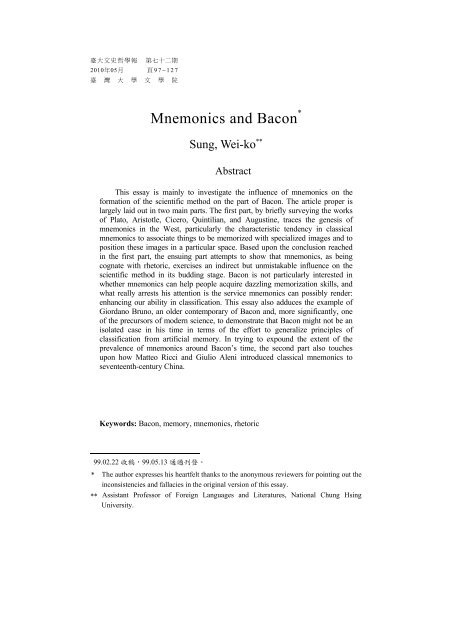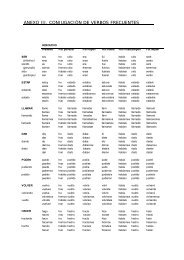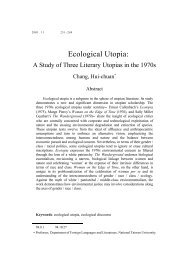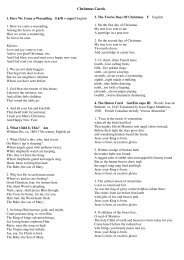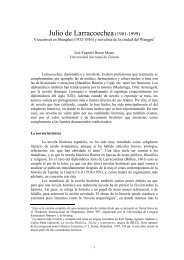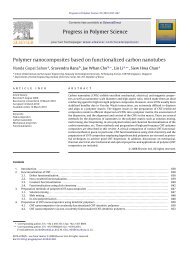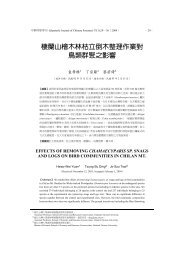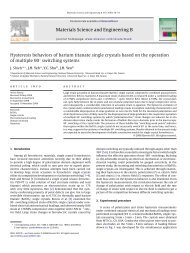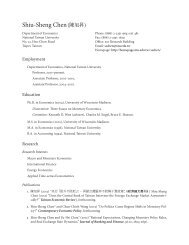Mnemonics and Bacon
Mnemonics and Bacon
Mnemonics and Bacon
You also want an ePaper? Increase the reach of your titles
YUMPU automatically turns print PDFs into web optimized ePapers that Google loves.
臺大文史哲學報 第七十二期<br />
2010年05月 頁97~127<br />
臺 灣 大 學 文 學 院<br />
<strong>Mnemonics</strong> <strong>and</strong> <strong>Bacon</strong> ∗<br />
Sung, Wei-ko ∗∗<br />
Abstract<br />
This essay is mainly to investigate the influence of mnemonics on the<br />
formation of the scientific method on the part of <strong>Bacon</strong>. The article proper is<br />
largely laid out in two main parts. The first part, by briefly surveying the works<br />
of Plato, Aristotle, Cicero, Quintilian, <strong>and</strong> Augustine, traces the genesis of<br />
mnemonics in the West, particularly the characteristic tendency in classical<br />
mnemonics to associate things to be memorized with specialized images <strong>and</strong> to<br />
position these images in a particular space. Based upon the conclusion reached<br />
in the first part, the ensuing part attempts to show that mnemonics, as being<br />
cognate with rhetoric, exercises an indirect but unmistakable influence on the<br />
scientific method in its budding stage. <strong>Bacon</strong> is not particularly interested in<br />
whether mnemonics can help people acquire dazzling memorization skills, <strong>and</strong><br />
what really arrests his attention is the service mnemonics can possibly render:<br />
enhancing our ability in classification. This essay also adduces the example of<br />
Giordano Bruno, an older contemporary of <strong>Bacon</strong> <strong>and</strong>, more significantly, one<br />
of the precursors of modern science, to demonstrate that <strong>Bacon</strong> might not be an<br />
isolated case in his time in terms of the effort to generalize principles of<br />
classification from artificial memory. In trying to expound the extent of the<br />
prevalence of mnemonics around <strong>Bacon</strong>’s time, the second part also touches<br />
upon how Matteo Ricci <strong>and</strong> Giulio Aleni introduced classical mnemonics to<br />
seventeenth-century China.<br />
Keywords: <strong>Bacon</strong>, memory, mnemonics, rhetoric<br />
99.02.22 收稿,99.05.13 通過刊登。<br />
∗ The author expresses his heartfelt thanks to the anonymous reviewers for pointing out the<br />
inconsistencies <strong>and</strong> fallacies in the original version of this essay.<br />
∗∗ Assistant Professor of Foreign Languages <strong>and</strong> Literatures, National Chung Hsing<br />
University.
98<br />
臺 大 文 史 哲 學 報<br />
1. A Brief Overview of Classical <strong>Mnemonics</strong><br />
This essay aims first to provide an overview of memory in the history of ideas<br />
<strong>and</strong>, thence, deals with how mnemonics helps mold <strong>Bacon</strong>’s scientific method. In an<br />
age that has witnessed many great strides in human technology of storing up<br />
information, it is difficult, if not impossible, for modern readers to envision that<br />
mnemonics played a significant role in Western civilization before the advent of<br />
printing. Indeed, the intertwining between memory <strong>and</strong> rhetoric dates back to<br />
ancient Greece. Mnemosyne, the goddess of memory <strong>and</strong> remembrance, represents<br />
“the necessary rote memorization to preserve history <strong>and</strong> sagas” before the invention<br />
of writing, <strong>and</strong> is accordingly depicted as the mother of the Muses. 1 What arrests<br />
our further attention is that in Greek mythology Mnemosyne is also represented as<br />
the inventor of language <strong>and</strong> words. 2 For example, in Plato’s Critias, Critias says<br />
that “But besides the gods <strong>and</strong> goddesses whom you have mentioned, I would<br />
specially invoke Mnemosyne; for all the important part of my discourse is dependent<br />
on her favour, <strong>and</strong> if I can recollect <strong>and</strong> recite enough of what was said by the priests<br />
<strong>and</strong> brought hither by Solon, I doubt not that I shall satisfy the requirements of this<br />
theatre” (529). 3<br />
1 I learned of this source from http://www.theoi.com/Titan/TitanisMnemosyne.html.<br />
2 Ibid.<br />
3 Caplan devotes a useful discussion of Mnemosyne’s varied profiles in ancient Greek<br />
literature. According to Caplan, the earliest characterization of Mnemosyne as the mother<br />
of the Muses dates back to Hesiod’s Theogany, wherein Mnemosyne is portrayed as the<br />
daughter of Earth <strong>and</strong> Heaven (Caplan 200). In his study of the making <strong>and</strong> recitation of<br />
epic, Chen similarly mentions the importance of “Mnēmosunē” for Homer (38); that is, in<br />
invoking the Muse, the poet entreats for, besides inspiration, a tenacious memory as well<br />
to recite his creation (103). In the Homeric Hymn to Hermes, the son of Maia “honors<br />
Mnemosyne in his song first among all the gods” (Caplan 200). For several other<br />
Greco-Roman deities associated with memory, see Caplan, p. 200. It should be further<br />
noted that the term “Homeric” should not mislead us to think that these Homeric hymns<br />
are composed by the creator of Iliad <strong>and</strong> Odyssey. The earliest reference to the Homeric<br />
hymns comes from Thucydides, who ascribes these hymns to Homer. These hymns are<br />
“Homeric” in that they share the same epic meter (dactylic hexameter), dialect, <strong>and</strong> style<br />
with Iliad <strong>and</strong> Odyssey (Rayor 1). These poems are “hymns” because they are devotional<br />
songs sung in honor of gods, “usually at a contest held as part of a religious festival or of<br />
some other solemn occasion” (Athanassakis xiv). Today the authorship of these Homeric<br />
Hymns remains a moot question. Interested readers can see Athanassakis, pp. xiii-xvii,<br />
<strong>and</strong> Rayor, pp. 1-13.
<strong>Mnemonics</strong> <strong>and</strong> <strong>Bacon</strong><br />
(1). Simonides, Cicero, Quintilian, <strong>and</strong> Rhetorica ad Herennium<br />
Another link between memory <strong>and</strong> rhetoric in Greek mythology can be found<br />
in the story of Simonides. 4 A nobleman from Thessaly named Scopas, the winner of<br />
a boxing contest, one day holds a banquet, <strong>and</strong> as one of the invited guests<br />
Simonides is commissioned to compose a panegyric in honor of the host. Because a<br />
portion of this poem digresses to eulogize Zeus’ illegitimate twin sons, Castor <strong>and</strong><br />
Pollux, the miserly host grumbles to Simonides that he will pay only half of the<br />
honorarium agreed on beforeh<strong>and</strong>, <strong>and</strong> that Simonides can ask for the remainder<br />
from the twins. Later someone comes into the banquet hall <strong>and</strong> informs the poet that<br />
two young men waiting outside would like to meet him. However, when Simonides<br />
leaves the banquet <strong>and</strong> steps outside the hall, he cannot spot anyone. At the instant<br />
Simonides steps outside, the roof of the banquet hall collapses <strong>and</strong> crushes the host,<br />
as well as all the other guests, to death. All the corpses are horrendously mangled,<br />
but Simonides remembers the seat arrangement of every single guest so that he can<br />
faultlessly relate it to those who intend to collect their relatives’ dead bodies.<br />
It is, however, worth our attention that the aforementioned story of Simonides<br />
as the inventor of mnemonics is not preserved in any extant Greek manuscripts, but<br />
set down by Cicero in his De Oratore (Yates 18). 5 According to Yates, Cicero relates<br />
this story to discuss memory as one of the five elements of rhetoric <strong>and</strong> to describe<br />
the mnemonics of “places” <strong>and</strong> images adopted by Roman orators (18). Another two<br />
classical treatments of mnemonics—Rhetorica ad Herennium (Rhetoric for<br />
Herennius) <strong>and</strong> Quintilian’s Institutio Oratoria—are at once treatises on rhetoric. 6<br />
4 Simonides (6th century-5th century, B.C.E.), whose birth <strong>and</strong> death cannot be accurately<br />
dated, is a Greek poet whose poetry is no longer extant except for some fragments<br />
allegedly authored by him. Plutarch ascribes the aphorism “painting is silent poetry <strong>and</strong><br />
poetry painting that speaks,” which inspires Lessing’s Laocoön, to Simonides (The<br />
Oxford Classical Dictionary 1409).<br />
5 In addition to Cicero, Quintilian several others have their own accounts of the story about<br />
Simonides as the inventor of mnemonics. Cicero’s <strong>and</strong> Quintilian’s versions are the most<br />
complete ones. There are, however, some discrepancies over the name of the winner of<br />
the boxing contest, <strong>and</strong> it is interesting to note that the divine twins, Castor <strong>and</strong> Pollux,<br />
are also famous for their pugilistic skills (Small 276). It is Yates’ pioneering The Art of<br />
Memory that engages my interest in the history of mnemonics. I am also greatly inspired<br />
by Rossi’s excellent treatment of the vicissitudes of the art of memory before <strong>and</strong> in<br />
<strong>Bacon</strong>’s time in his Logic <strong>and</strong> the Art of Memory: The Quest for a Universal Language.<br />
6 Rhetoric for Herennius, the earliest extant work on all the five aspects of rhetoric, had<br />
been considered Cicero’s work through the Middle Ages (Kennedy 121). It is Jerome, the<br />
foremost contributor to the formation of the Vulgate Bible, who ascribes the authorship of<br />
99
100<br />
臺 大 文 史 哲 學 報<br />
Since the Greek sources Rhetorica ad Herennium draws on, which per se are<br />
treatises on rhetoric, are all lost, the historical uniqueness of Rhetorica ad<br />
Herennium speaks for itself (Kennedy 123; Yates 21). This unknown author of<br />
Rhetorica ad Herennium, following Aristotle, suggests that an ideal orator possess<br />
the following elements: inventio, dispositio, elocutio, memoria, <strong>and</strong> pronuntiatio.<br />
And in mnemonics what matters the most is locus <strong>and</strong> images, <strong>and</strong> a locus is “a<br />
place easily grasped by the memory, such as a house, an intercolumnar space, a<br />
corner, an arch, or the like. Images are forms, marks or simulacra of what we wish to<br />
remember” (Yates 22). 7<br />
It should also be noted that the role of memory in rhetoric is not restricted to<br />
the fivefold scheme mentioned in the preceding paragraph. The connection between<br />
memory <strong>and</strong> rhetoric can be investigated from other angles. The author of Rhetorica<br />
ad Herennium, for example, contends that memory occupies a significant role in the<br />
tripartite definition of wisdom (prudentia). Wisdom, it states, is tantamount to<br />
“intelligence capable… by a certain judicious method, of distinguishing good <strong>and</strong><br />
bad” (III. ii; 162). A parallel idea can be found in De Inventione, where Cicero<br />
defines wisdom as the caliber to distinguish the good from the bad (II. lii; 327). And<br />
the essential elements of wisdom are memory, intelligence, <strong>and</strong> foresight; memory,<br />
suggests Cicero, is “the faculty by which the mind recalls what has happened” (II. lii;<br />
327). 8 Yates indicates that Cicero’s definition of wisdom in De Inventione serves as<br />
a significant precursor in molding what later becomes known as “the four cardinal<br />
virtues.” 9 When elaborating on the four cardinal virtues, both Albertus Magnus <strong>and</strong><br />
Thomas Aquinas adduce Cicero’s definition of prudence, <strong>and</strong>, more importantly, it is<br />
the prestige associated with the name “Cicero” that rivets medieval scholars’<br />
attention to the art of memory (Yates 20).<br />
(2). Plato, Aristotle, <strong>and</strong> Wax Tablet<br />
Rhetoric for Herennius to Cicero (Wilkins 51). Now the authorship of Rhetoric for<br />
Herennius remains an inconclusive question. For useful discussions, see Kennedy, pp.<br />
121-26, <strong>and</strong> Wilkins, pp. 51-56.<br />
7 In addition to locus <strong>and</strong> images, architecture is also closely connected with mnemonics.<br />
For the connection between architecture <strong>and</strong> mnemonics, see Mary Carruthers’ excellent<br />
treatment in The Craft of Thought: Meditation, Rhetoric, <strong>and</strong> the Making of Images,<br />
400-1200 (Cambridge: Cambridge UP, 1998), pp. 7-24.<br />
8 Whereas intelligence is the faculty “by which it [the mind] ascertains what is,” foresight<br />
is the faculty “by which it is seen that something is going to occur before it occurs” (De<br />
Inventione II, lii; 327).<br />
9 The four cardinal virtues are prudence, justice, fortitude, <strong>and</strong> temperance.
<strong>Mnemonics</strong> <strong>and</strong> <strong>Bacon</strong><br />
One recurrent metaphor can be spotted in all the three Latin works introduced<br />
in the preceding section: All liken the inner pressing of images on memory to the<br />
markings on a wax tablet. The possible reason for this analogy is twofold. First, this<br />
metaphor attests to the prevalence of wax tablet as a writing device in ancient times.<br />
Second, this metaphor is indicative of an inherent link between ancient mnemonics<br />
<strong>and</strong> contemporary theories of memory (Yates 50). The metaphor of wax tablet can<br />
be traced back to Plato’s Theaetetus. In conversing with Theaetetus, Socrates says:<br />
“I would have you imagine, then, that there exists in the mind of man a block of wax,<br />
which is of different sizes in different men; harder, moister, <strong>and</strong> having more or less<br />
of purity in one than another, <strong>and</strong> in some of an intermediate quality” (254). This<br />
tablet, adds Socrates, is a gift of Memory [sic], the mother of the Muses:<br />
When we wish to remember anything which we have seen, or heard, or<br />
thought in our own minds, we hold the wax to the perceptions <strong>and</strong><br />
thoughts, <strong>and</strong> in that material receive the impression of them as from the<br />
seal of a ring; <strong>and</strong> that we remember <strong>and</strong> know the image lasts; but when<br />
the image is effaced, or cannot be taken, then we forget <strong>and</strong> do not know.<br />
(Theaetetus 255)<br />
From a tripartite conversation among Cebes, Simmias, <strong>and</strong> Socrates in Phaedo,<br />
we are told one of Socrates’ favorite precepts: Knowledge is simply recollection<br />
(213). Though Socrates defines recollection as “a process of recovering that which<br />
has been already forgotten through time <strong>and</strong> inattention” <strong>and</strong> makes no mention of<br />
the term “association,” he suggests that recollection generally refers to one’s ability<br />
to derive the underst<strong>and</strong>ing of someone or something from some other person or<br />
something else (214). That is, even though the term “mnemonics” might never cross<br />
Socrates’ mind, the preliminary techniques of mnemonics have already been<br />
prefigured by Socrates. For example, Socrates finds out that people might remember<br />
their lovers at the sight of the lyres belonging to their beloved: “Do not they, from<br />
knowing the lyre, form in the mind’s eye an image of the youth to whom the lyre<br />
belongs?” (214)<br />
The advent of writing, for Socrates, will blunt our memory. The intertwining<br />
between writing <strong>and</strong> memory is reminiscent of a notable episode in Phaedrus, where<br />
Socrates <strong>and</strong> Phaedrus trade ideas about the essence of writing <strong>and</strong> its detrimental<br />
effect on the faculty of memory. 10 In Phaedrus, the young Phaedrus, an enthusiastic<br />
10 Anyone with a certain familiarity with Derrida’s works will not fail to recognize the<br />
importance of this story in Derrida’s speculation on the dialectical relation between<br />
speech <strong>and</strong> writing. See Derrida, “The Filial Inscription: Theuth, Hermes, Thoth, Nabû,<br />
Nebo” <strong>and</strong> “The Pharmakon,” in Dissemination (Chicago: U of Chicago P, 1981), pp.<br />
101
102<br />
臺 大 文 史 哲 學 報<br />
admirer of the famed rhetorician of that time, Lycias, intends to recite a speech of<br />
Lycias to Socrates. What is interesting is that while Phaedrus has readied himself for<br />
reciting Lycias’ speech to Socrates from memory, Socrates, glimpsing a roll under<br />
Phaedrus’ cloak, insists that Phaedrus “read” the speech verbatim since he has a<br />
manuscript at h<strong>and</strong>: “Much as I love you, I would not have you suppose that I am<br />
going to have your memory exercised at my expense.” To which Phaedrus responds,<br />
“Enough; I see that I have no hope of practicing my art upon you” (433). This<br />
passage is significant in that even though Phaedrus feels a little sullen over being<br />
prevented from showcasing his memory (his art), before long he still reverts to his<br />
art in his dialogue with Socrates.<br />
Whilst the whole dialogue between Phaedrus <strong>and</strong> Socrates is generally centered<br />
upon the essence of love, near its end the conversation digresses into a discussion on<br />
writing. Socrates tells Phaedrus that in Egypt there was an old man named Theuth,<br />
who was noted for his wisdom <strong>and</strong> was the purported inventor of many arts such as<br />
arithmetic, calculation, geometry, astronomy, draughts, dice, <strong>and</strong>, most importantly,<br />
the use of letters. At that time the king of Egypt was the god Thamus, <strong>and</strong> he tried to<br />
appraise each invention when Theuth presented the inventions to him. When they<br />
finally came to the letters, Theuth claimed that these letters could make the Egyptian<br />
people wiser <strong>and</strong> enhance their memories. Thamus, however, thought otherwise:<br />
“For this discovery of yours will create forgetfulness in the learners’ souls, because<br />
they will not use their memories; they will trust to the external written characters<br />
<strong>and</strong> not remember of themselves . . . they will be hearers of many things <strong>and</strong> will<br />
have learned nothing; they will appear to be omniscient <strong>and</strong> will generally know<br />
nothing” (Phaedrus 484). These qualms about writing are not a unique case. At least<br />
a similar resonance can be heard in Emerson though the target of complaint is not<br />
altogether identical. In an essay entitled “On Memory” Emerson writes: “Plato<br />
deplores writing as a barbarous invention which would weaken the memory by<br />
disuse…. If writing weakens the memory, we may say as much <strong>and</strong> more of printing.<br />
What is the newspaper but a sponge or invention for oblivion?” (99)<br />
With only slight variations, the metaphor of wax tablet can also be found in<br />
Aristotle. In De Memoria et Recollection (On Memory), Aristotle contends that the<br />
way experience leaves an image in our memory is not unlike that people “make an<br />
impression with a seal” (450 a 31-32). Thus, memory, writes Aristotle, does not occur<br />
in those “who are strongly moved owing to passion, or time of life, no memory is<br />
formed; just as no impression would be formed if the movement of the seal were to<br />
impinge on running water” (450 b 1-3). Similarly, Aristotle obviously believes that the<br />
84-94, pp. 95-117.
<strong>Mnemonics</strong> <strong>and</strong> <strong>Bacon</strong><br />
“imprint” nature of memory can help explain why the memory of infants <strong>and</strong> of the<br />
aged either teeters or falters because they are in “a state of flux, the former [infants]<br />
because of their growth, the latter [the aged], owing to their decay” (450 b 7-8).<br />
Aristotle continues his argument <strong>and</strong> comes up with the conclusion: “both those who<br />
are too quick <strong>and</strong> those who are too slow have bad memories. The former are too<br />
moist, the latter too hard, so that in the case of the former the image does not remain<br />
in the soul, while on the latter it is not imprinted at all” (450 b 8-11). The author of<br />
Rhetorica ad Herennium also mentions wax tablets when elucidating the concept of<br />
“backgrounds”: “For the images, like letters, are effaced when we make no use of<br />
them, but the backgrounds, like wax tablets, should abide” (III. xviii; 211).<br />
Carruthers, however, alerts us that the image of wax tablet is by no means<br />
uniquely Greco-Roman, since it can also be found in, for example, Proverbs: 11 “Let<br />
not loyalty <strong>and</strong> faithfulness forsake you; bind them about your neck, write them on<br />
the tablet of your heart” (3:3). Both Carruthers <strong>and</strong> Draaisma point out that the sway<br />
of this array of interrelated images, such as “imprinting,” “write upon,” or “wax<br />
tablets,” could still be keenly felt long after the wax tablet had given way to codex<br />
<strong>and</strong> other writing materials. For example, while investigating the nature of light <strong>and</strong><br />
how the human eyes receive light, Thomas Aquinas writes: “Aristotle finds an apt<br />
example of this in the imprint of a seal on wax. The disposition of the wax to the<br />
image is not the same as that of the iron or gold to the image; hence wax, he says,<br />
takes a sign, i.e. a shape or image, of what is gold or bronze, but not precisely as [sic]<br />
gold or bronze” (172). 12<br />
Actually, the notion of memory as an integral ingredient of wisdom dissected in<br />
the previous section is no less salient in Aristotle. For example, for Aristotle a good<br />
memory, together with other elements such as good parts, receptiveness, quickness<br />
of intuition, is conducive to excellence in virtue (1362 b 23-24). In De Memoria et<br />
Recollection, Aristotle reminds us of the essential correlation between memory <strong>and</strong><br />
imagination: “It is apparent, then, to which part of the soul memory belongs, namely<br />
the same part as that to which imagination belongs. And it is the objects of<br />
imagination that are remembered in their own right, whereas things that are not<br />
grasped without imagination are remembered in virtue of an incidental association”<br />
(450 a 22-23). Sorabji’s gloss on this passage runs as follows: “in its own right (kath’<br />
11 Carruthers notes that the trace of Greek influence on Proverbs is easily recognizable (29).<br />
12 As for the metaphor of memory as the apparatus to record words in the soul, Caplan<br />
enumerates more examples, which include passages excerpted from Aeschylus (“The<br />
unforgetting tablets of thy mind”); Shakespeare (“the table of my memory”); Longfellow<br />
(“leaves of memory”). See Caplan, pp. 213-14.<br />
103
104<br />
臺 大 文 史 哲 學 報<br />
hauto), but in virtue of an incidental association” (79). In a more direct fashion<br />
Caplan explains the crux of this passage; Aristotle simply points out a fact that must<br />
be familiar to today’s readers: Things bearing necessary associations are more easily<br />
recollected (203). Furthermore, these laws of association, similarity, contrast, <strong>and</strong><br />
contiguity are at work not only in mnemonics but also in the theory of style, since<br />
these laws involve the use of simile, metaphor, <strong>and</strong> contrast (Caplan 204). For<br />
sophists such as Protagoras, Gorgias, or Hippias, memory had long been an<br />
important device to further their already dazzling skills of improvisation (Caplan<br />
206).<br />
More contemporary evidence for the pervasiveness of mnemonics in the<br />
ancient world can be adduced in Aristotle, who explicitly refers to artificial memory<br />
on different occasions in his corpus. Indeed, the best ancient reflection on the<br />
psychology of memory is contained in Aristotle’s works, especially De Memoria et<br />
Recollection <strong>and</strong> De Anima (On the Soul). 13 According to Aristotle, the states of<br />
mind run, in chronological order, as follows: perception, memory, experience, <strong>and</strong>,<br />
last, a principle of skill <strong>and</strong> of underst<strong>and</strong>ing (Posterior Analytics 100 a 4-8). 14<br />
Similarly, in Topics Aristotle advises that concerning those questions of most<br />
frequent occurrence people should always be ready to put them into memory: “For<br />
just as in a person with a trained memory, a memory of things themselves is<br />
immediately caused by the mere mention of their ‘places,’ so these habits too will<br />
make a man readier in reasoning, because he has his premises classified before his<br />
mind’s eye, each under its number” (163 b 28-31). In this sense, it is interesting to<br />
note the correlation between locus <strong>and</strong> topoi here because it is quite possible that the<br />
title of Aristotle’s Topics derives from the “places” in mnemonics (Yates 46). 15<br />
Yet it should be clarified that Aristotle begins his treatise on memory by<br />
differentiating memory (remembering) from reminiscing (recollecting). Memory,<br />
Aristotle avers, is essentially related to the past (De Memoria et Recollection<br />
449 b 14), since it makes no sense if one claims that he or she is remembering the<br />
present. On the other h<strong>and</strong>, recollecting is “neither the recovery nor the acquisition<br />
13 This judgment is rendered by Léon Robin: “All that was best in orthodox psychology [of<br />
memory] down to the end of the XIX century is contained, in sum, in a few pages of<br />
Aristotle” (301).<br />
14 Aristotle, in Posterior Analytics, defines perception as “a connate discriminatory<br />
capacity” (99 b 35). As for “a principle of skill <strong>and</strong> of underst<strong>and</strong>ing,” Aristotle’s<br />
definition is as follows: “Of skill if it deals with how things come about, of underst<strong>and</strong>ing<br />
if it deals with what is the case” (100 a 8-9).<br />
15 Both the Latin word locus <strong>and</strong> the Greek word topoi mean “place” in English.
<strong>Mnemonics</strong> <strong>and</strong> <strong>Bacon</strong><br />
of memory” (451 a 19-20). Couched in layman’s terms, recollection is a “being<br />
reminded” <strong>and</strong> involves “one thing putting us in mind of another” (Krell 13). In a<br />
word, for Aristotle, having a good memory cannot be equated with being good at<br />
recollecting: “For the persons who possess a retentive memory are not identical with<br />
those excel in power of recollection; indeed, as a rule, slow people have a better<br />
memory, whereas those who are quick-witted <strong>and</strong> clever are better at recollecting”<br />
(449 b 6-9). 16<br />
(3). Augustine<br />
St. Augustine in his Confessions expresses an unreserved accolade on the<br />
faculty of memory <strong>and</strong> makes a profound meditation on the mystery of memory. 17<br />
For example, in Book X Augustine writes: “Great is the power of memory,<br />
exceeding great, O my God—an inner chamber large <strong>and</strong> boundless! Who has<br />
plumbed its depths?... A great admiration rises upon me; astonishment seizes<br />
me….And men go forth to wonder at the heights of mountains, the huge waves of<br />
the sea, the broad flow of the rivers, the extent of the ocean, <strong>and</strong> the courses of the<br />
stars, <strong>and</strong> omit to wonder at themselves” (154). 18 Indeed, Augustine is captivated<br />
with one of his friend’s astonishing memory. Once Augustine asks this friend named<br />
Simplicius what the penultimate lines in each of Virgil’s works are, Simplicius,<br />
without the slightest hesitation, waltzes through this challenge (Augustine 1956:<br />
358). It is noteworthy that as in Cicero’s discussion of memory, Augustine,<br />
impressed with his friend’s bent for memorization, believes that locus <strong>and</strong> images<br />
play important roles in the functioning of memory: “And I enter the fields <strong>and</strong><br />
roomy chambers of memory, where are the treasures of countless images, imported<br />
16 A short but useful account of the nuance between remembering <strong>and</strong> recollecting in the<br />
light of Greek etymology is provided by Richard Sorabji, p. 35.<br />
17 In a very short article entitled “Memory <strong>and</strong> Confession”(〈記憶與懺悔〉)Sher-shiueh<br />
Li points out the interdependent relationship between memory <strong>and</strong> confession: But for<br />
memory, how can we capture the past in the flux of time? Conversely, people would feel<br />
conscience-stricken when they try to recall a regrettable past (376). It is worthwhile to<br />
note that though Li illustrates his argument mainly by the example of The Journey to the<br />
West (《西遊記》), he mentions Augustine’s Confessions at the outset of his article.<br />
18 Augustine’s wonderment at the infinite immensity of memory finds an echo in the<br />
writings of Giulio Aleni (艾儒略): 「聖奧斯定云,涉記乃浩大之淵,不知何等,<br />
乃有無涯容受。亦深窈,亦顯明,難以言語揣摹」(240). I owe an anonymous reviewer<br />
of an earlier version of this essay for the reference to Aleni’s works. An Italian Jesuit<br />
missionary, Giulio Aleni (1582-1649), following in Matteo Ricci’s (利瑪竇) footsteps,<br />
arrived in China in 1609 <strong>and</strong>, thence, embarked on his missionary work (Pan 6).<br />
105
106<br />
臺 大 文 史 哲 學 報<br />
into it from all manner of things by the senses” (Confessions 152-53). Lines later<br />
Augustine makes it clear that it is the images of things, not the things themselves,<br />
that are stored up in memory (153). Augustine goes further in claiming that many<br />
more branches of knowledge (literature <strong>and</strong> rhetoric included) are “taken from the<br />
memory”: “And yet are not these all that the illimitable capacity of my memory<br />
retains. Here also is all that is apprehended of the liberal sciences, <strong>and</strong> not yet<br />
forgotten—removed as it were into an inner place, which is not a place … For what<br />
is literature, what skill in disputation, whatsoever I know of all the many questions<br />
there are, is so in my memory” (154). What arrests our attention here is that what<br />
occurs to Augustine first, as far as memory is concerned, is literature <strong>and</strong> skill in<br />
disputation. That is, this quotation again displays the link between memory <strong>and</strong><br />
rhetoric.<br />
Despite Augustine’s exuberant reflection on memory, the essence of memory<br />
remains a recondite enigma to him. The mysterious essence of memory more eludes<br />
Augustine when he juxtaposes forgetfulness with memory in his attempt to elucidate<br />
memory: “I name memory, <strong>and</strong> I know what I name. But where do I know it<br />
[forgetfulness], except in the memory itself? Is it also present to itself by its images,<br />
<strong>and</strong> not by itself?” (Confessions 158). On the essence of forgetfulness, Augustine<br />
remarks that “But when I remember forgetfulness, there are present both memory<br />
<strong>and</strong> forgetfulness—memory, whereby I remember, forgetfulness, which I remember.<br />
But what is forgetfulness but the privation of memory? How, then, is that present for<br />
me to remember, since, when it is so, I cannot remember?” (159). Then Augustine<br />
reiterates his experience of being spellbound by the inscrutability of memory: “Great<br />
is the power of memory; very wonderful is it. O my God, a profound <strong>and</strong> infinite<br />
manifoldness” (160). 19<br />
2. <strong>Mnemonics</strong> <strong>and</strong> <strong>Bacon</strong><br />
For most modern readers, the prevalence of mnemonics before the advent of<br />
printing is imaginable. However, a question naturally rises: Could mnemonics retain<br />
its glory after printing made access to knowledge not only possible but also easy?<br />
That is, if people want to read anything they think of, they have easy access to<br />
whatever they want. Generally speaking, mnemonics has been gradually superseded<br />
<strong>and</strong> sidelined by printing since the fifteenth century. Though the decline of<br />
19 For a more detailed discussion of how Augustine conceptualizes memory in the empirical<br />
sense, see Gerald O’Daly’s Augustine’s Philosophy of Mind (Berkeley: U of California P,<br />
1987), pp. 131-51.
<strong>Mnemonics</strong> <strong>and</strong> <strong>Bacon</strong><br />
mnemonics had been an unstoppable tendency in the wake of the growing wide<br />
prevalence of printing, it played a constituent role in the formation of <strong>Bacon</strong>’s<br />
scientific method in the seventeenth century.<br />
(1). Ricci <strong>and</strong> Aleni<br />
Before we investigate <strong>Bacon</strong>’s own ideas of memory, a particular mention of<br />
Matteo Ricci’s works can give us a glimpse of the extent to which ancient, classical<br />
mnemonics still remained strong around the threshold of the seventeenth century.<br />
Though Italy <strong>and</strong> Engl<strong>and</strong> are geographically <strong>and</strong>, more crucially, religiously apart,<br />
the ensuing overview of Ricci’s art of memory will reveal that classical mnemonics<br />
proposed by Quintilian <strong>and</strong> in Rhetorica ad Herennium was then still a fundamental<br />
part of the st<strong>and</strong>ard curriculum in the Catholic world. Ricci arrived in China <strong>and</strong> fell<br />
to his missionary work in 1583. With an unusual caliber for language learning,<br />
before long Ricci became fluent in Chinese <strong>and</strong> could converse with average<br />
Chinese people effortlessly. To promote his missionary work, Ricci began to<br />
cultivate local Chinese scholars <strong>and</strong> to seize every opportunity to showcase his<br />
mnemonics to his Chinese acquaintances at drinking parties. It was reported that<br />
Ricci could recite, in their entirety, the passages from Chinese classics impromptu<br />
assigned to him (Zhu 141; Spence 3-4). This spectacular feat quickly turned Ricci<br />
into a luminary in Nanchang, 20 <strong>and</strong> many Chinese officers <strong>and</strong> literati earnestly<br />
invited Ricci to the banquets held in their residences, <strong>and</strong> finely wined <strong>and</strong> dined<br />
him. When Ricci’s reputation reached the governor of Jiangxi, Lu Wangai, 21 Lu sent<br />
for Ricci to coach his three sons in mnemonic techniques. 22 Ricci, feeling honored<br />
but also beset by Lu’s sincere invitation, decided to spell out his art of memory in a<br />
slim book entitled Ji fa. 23<br />
Ricci begins his Ji fa with a general survey of the nature of memory, <strong>and</strong><br />
Plato’s <strong>and</strong> Aristotle’s influence on him is unmistakable. For example, like Aristotle<br />
Ricci believes that images are imprinted on our memory, <strong>and</strong> that this “imprint”<br />
nature of memory can help elucidate why the memory of infants fares ill <strong>and</strong> that of<br />
the aged degenerates. For Ricci, the brain of the child is too soft to keep the imprint<br />
intact; on the other h<strong>and</strong>, the gradually hardening brain of the elderly is no longer<br />
20 江西南昌<br />
21 陸萬陔<br />
22 To pass the advanced government examination entails memorizing volumes of Chinese<br />
classics.<br />
23 《記法》or《西國記法》. The only extant original copy of Ricci’s Ji fa is now housed in<br />
a library in Paris (Zhu 142).<br />
107
108<br />
臺 大 文 史 哲 學 報<br />
conducive to the imprinting of images. Thus, both children <strong>and</strong> the aged have<br />
difficulty memorizing things <strong>and</strong>, therefore, are prone to forgetfulness (2001:<br />
143-44). Though Ricci does not specify the sources of his conceptions of memory,<br />
we, in the light of the striking similarity between Ricci <strong>and</strong> Aristotle, can hardly<br />
avoid the conclusion that Ricci is greatly indebted to Aristotle for the notion of<br />
memory.<br />
Likewise, Ricci is well aware of the tradition emanating from Simonides <strong>and</strong><br />
accordingly credits the invention of mnemonics to Simonides. 24 To remember<br />
things, Ricci emphasizes that each item be given an image, <strong>and</strong> that we should<br />
assign a place for everything we try to remember. While mnemonic skills made up<br />
an integral part of the curriculum Ricci received at the Jesuit College in Rome, two<br />
overriding influences on Ricci’s guidelines for constructing memory edifices were<br />
Quintilian <strong>and</strong> Rhetorica ad Herennium (Spence 5). In her monograph on Giordano<br />
Bruno (1548-1600), Rowl<strong>and</strong> clearly points out that the art of memory made up an<br />
essential part of grammar-school education in sixteenth-century Italy, <strong>and</strong> that<br />
seminary students would harness mnemonic skills to memorize different kinds of<br />
theological works, including the Scriptures, sermons, <strong>and</strong> canon law, to hoard up<br />
preaching materials or to spiritually exercise themselves (62). Echoing Quintilian<br />
<strong>and</strong> Rhetorica ad Herennium, Ricci foregrounds the import of assigning different<br />
places to the images of the things we intend to memorize. Ricci indicates that these<br />
places generally fall into three sizes in accordance with the number of things one<br />
would like to memorize: “If you are going to use a great many [images], then let the<br />
buildings be hundreds or thous<strong>and</strong>s of units in extent; if you only want a few, then<br />
take a single reception hall <strong>and</strong> just divide it up by its corners.” 25<br />
24 The original passage is as follows: 「古西詩伯西末泥德嘗與親友聚飲一室,賓主甚<br />
眾,忽出室外,其堂隨為迅風摧崩,飲眾悉壓而死,其尸齎粉,家人莫能辨識。西<br />
末泥德因憶親友坐次行列,乃一一記而別之,因悟記法 創此遺世焉。」 (2001: 146).<br />
The box represents a smudged <strong>and</strong>, therefore, illegible Chinese character (2005: 6).<br />
25 Here I follow Spence’s translation (9-10). The following passage excerpted from Ricci’s<br />
Chinese original can shed more light on the importance of architecture in his mnemonic<br />
system <strong>and</strong>, more importantly, his indebtedness to Quintilian <strong>and</strong> Rhetorica ad<br />
Herennium: 「凡記法,須預定處所,以安頓所記之象。處所分三等,有大,有中,<br />
有小。其大則廣宇大第,若公府,若黌宮,若寺觀,若邸居,若舍館,自數區至數<br />
十百區,多多益善。中則一堂,一軒,一齋,一室。小則室之一隅,或一神龕,或<br />
倉櫃座榻。……用多,則廣宇千百間,少,則一室可分方隅,要在臨時斟酌,不可<br />
拘執一轍」 (2001: 148). A parallel argument can be found in Aleni: 「西國有習之<br />
者,法雖不一,各有訣焉。大概先在心中,備一宏大之宇。或為曾熟遊,或為暫所
<strong>Mnemonics</strong> <strong>and</strong> <strong>Bacon</strong><br />
Though Ricci, on the whole, remains a loyal disciple of classical mnemonics as<br />
revealed in Ji fa, he sometimes modifies traditional techniques to facilitate his<br />
missionary work in China. For example, the author of Rhetorica ad Herennium<br />
reminds the reader that when faced with a surfeit of images it is desirable to put<br />
marks at regular intervals: “And that we may by no chance err in the number of<br />
backgrounds, each fifth background should be marked. For example, if in the fifth<br />
we set a golden h<strong>and</strong>, <strong>and</strong> in the tenth some acquaintance whose first name is<br />
Decimus, it will then be easy to station like marks in each successive fifth ground”<br />
(III. xvii; 211). 26 However, always mindful of his mission to convert the Chinese to<br />
Catholicism, Ricci suggests that his Chinese readers can insert a Chinese character<br />
十 at every tenth memory image. 27 The Chinese ideograph 十 proposed in Ricci’s<br />
mnemonic tract for Chinese readers, notes Spence, is at once a reminder of the<br />
decimal system <strong>and</strong>, more importantly, of the profound symbolism intimated by the<br />
cross (23).<br />
The foregoing vignette of Ricci, who is nine years <strong>Bacon</strong>’s senior, 28 is meant<br />
to note the fact that on the threshold of the seventeenth century classical mnemonics<br />
still remained vigorous <strong>and</strong> retained a firm foothold in the training curriculum of<br />
Jesuit missionaries. Some people might demur, arguing Ricci’s <strong>and</strong> Aleni’s cases are<br />
only an isolated, singular piece of evidence falling shy of being a compelling proof<br />
that <strong>Bacon</strong> is also aware of classical mnemonics. This argument is certainly<br />
justifiable, but it should be emphasized again that the mnemonic techniques Ricci<br />
instructs to the Chinese amply demonstrate that classical mnemonics, typified by<br />
Quintilian’s treatise <strong>and</strong> Rhetorica ad Herennium, still retained its momentum on the<br />
Continent of the sixteenth century. Spence proffers several other examples wherein<br />
mnemonics came under attack. The thinkers or writers mentioned by Spence,<br />
including Cornelius Agrippa, Erasmus, Melanchthon, <strong>and</strong> Rabelais, either discredit<br />
the usefulness of these mnemonic devices or bitterly berate that these mnemonic<br />
structures, rather than enlighten people, will eventually stifle their development in<br />
假設。其中殿廡樓臺,堂館亭 榭,園林池沼,峭壁浮屠,無奇不 偹 ,無珍不錯。或<br />
半生成,半 剏 制,如穴中塑像,山頂立亭,各部署而排列焉。」(285-86).<br />
26 The number of fingers on a h<strong>and</strong> is used as a reminder of the number “five,” <strong>and</strong> the Latin<br />
word “decimus” means “tenth.” Aleni, in his elucidation of mnemonics, also mentions the<br />
use of a “golden h<strong>and</strong>”: 「然此法之妙,亦不全在乎多,而在乎熟。轉念之間,即億<br />
誰首誰次,本位毫釐不差。又或每排五象,即間一金掌。」(287).<br />
27 「又不論虛實,序成行列,編成字號,如每至十所一號,記一十字,總記幾十幾號,<br />
以便查考,以便聯絡應用,庶免紊亂。」 (2001: 148).<br />
28 Matteo Ricci (1552-1610); Francis <strong>Bacon</strong> (1561-1626).<br />
109
110<br />
臺 大 文 史 哲 學 報<br />
intelligence (Spence 12). For example, in Of the Vanitie <strong>and</strong> Uncertaintie of Artes<br />
<strong>and</strong> Sciences, Agrippa’s undisguised contempt for mnemonics comes at full blast: “It<br />
is a shameful thinge, <strong>and</strong> a shameless mannes propertie to set out in al mens sighte,<br />
the readings of many thinges, like as Marchantes do theire wares: whereas in the<br />
meane while the howse is emptie” (qtd. in Spence 25). 29<br />
(2). Prenotion, Emblem, <strong>and</strong> Place<br />
When we speak of the correlation between memory <strong>and</strong> <strong>Bacon</strong>’s works, we<br />
might think of <strong>Bacon</strong>’s partition of all human knowledge into three different realms:<br />
history, poetry, <strong>and</strong> philosophy. In “A Description of the Intellectual Globe,” <strong>Bacon</strong><br />
argues that the demarcation into history, poetry, <strong>and</strong> philosophy is based on three<br />
different faculties the three realms respectively entail: “History answers to memory,<br />
Poetry to imagination, <strong>and</strong> Philosophy to reason” (97). According to Rossi, <strong>Bacon</strong>’s<br />
treatment of memory in The Advancement of Learning is, on the whole, not at odds<br />
with the Renaissance conception of memory (1968: 207). Thus, it is beneficial to<br />
have a basic underst<strong>and</strong>ing of the intellectual climate around <strong>Bacon</strong>’s time. The<br />
statistic that Rhetorica ad Herennium passed through about twenty editions between<br />
1470 <strong>and</strong> 1569 (Rossi 1968: 208) suggests that the topological mnemonic system<br />
initiated by Quintilian <strong>and</strong> Rhetorica ad Herennium still retained its momentum in<br />
the first half of the sixteenth century. And as Rossi suggests, the tripartite themes of<br />
contemporary mnemonic works are “the notion of an encyclopedia of knowledge,<br />
the idea of an artificial memory laying foundation for a ‘perfect science,’ <strong>and</strong> the<br />
concept of an art of memory as a way of expelling ambiguity <strong>and</strong> establishing ‘order<br />
<strong>and</strong> coherence’ in arguments” (1968: 208).<br />
Though mnemonics was still at work in the corpuses of <strong>Bacon</strong>, Descartes, <strong>and</strong><br />
Leibniz, it had transformed itself from “a method of memorizing the encyclopedia”<br />
to “an aid for investigating the encyclopedia <strong>and</strong> the world” (Yates 355). <strong>Bacon</strong><br />
himself was undoubtedly aware of a few mnemonic skills. In John Aubrey’s<br />
biographical sketch of <strong>Bacon</strong>, we encounter the following depiction: “Over this<br />
Portico is a stately Gallerie, whose Glasse-windowes [sic] are all painted: <strong>and</strong> every<br />
pane with several figures of beest [sic], bird, or flower: perhaps his Lordship [<strong>Bacon</strong>]<br />
might use them as Topiques for Locall memorie [sic]” (14). 30 Besides, frequent,<br />
29 As for Spence’s brief discussion of Erasmus, Melanchthon, <strong>and</strong> Rabelais, see Spence, pp.<br />
12-13.<br />
30 John Aubrey (1626-1697) is best known for his “vivid, intimate, <strong>and</strong> sometimes acid”<br />
sketches of his contemporaries, which appeared as Lives of Eminent Men in 1813. The<br />
source of the information in this note is The New Encyclopedia Britannica, Vol. 1, pp.
<strong>Mnemonics</strong> <strong>and</strong> <strong>Bacon</strong><br />
explicit references to “collection of loci” <strong>and</strong> “artificial memory” bear eloquent<br />
testimony to the fact that <strong>Bacon</strong> is not entirely unfamiliar with contemporary art of<br />
memory (Rossi 2000: 103). One occasion where <strong>Bacon</strong> mentions memory is The<br />
Advancement of Learning, in which he regards memory, together with writing, as a<br />
means to retain knowledge (397). This passage is significant because it is a<br />
seventeenth-century counterpart of Socrates’ depreciation of writing. The merit of<br />
writing, says <strong>Bacon</strong>, lies in the fact that it can help digest <strong>and</strong> preserve knowledge in<br />
a sound “disposition” <strong>and</strong> “collocation” (398). However, it is interesting to note that<br />
in <strong>Bacon</strong>’s passages we can also trace the misgivings among his contemporaries<br />
about the possible disservice writing might do to memory because for them writing<br />
causes “a retardation of reading, <strong>and</strong> some sloth or relaxation of memory” (398).<br />
<strong>Bacon</strong> does not altogether deny the validity of this complaint, but he still attaches<br />
great importance to writing, since it “assureth copie of invention, <strong>and</strong> contracteth<br />
judgment to a strength” (398). On the other h<strong>and</strong>, <strong>Bacon</strong> indicates that his coevals<br />
do not fully underst<strong>and</strong> to what extent memory can contribute with regard to the<br />
retention of knowledge (398). In general, <strong>Bacon</strong> frowns upon the mnemonics of his<br />
time, <strong>and</strong> suggests that memorization skills should undergo necessary improvements<br />
before they are actually put into practice: “An art there is extant of it; but it seemeth<br />
to me that there are better precepts than that art, <strong>and</strong> better practices of that art than<br />
those received” (398). People might be spellbound or dumbfounded by varied<br />
dazzling displays of those with prodigious memory, 31 but, admonishes <strong>Bacon</strong>, the<br />
extant mnemonics is still not applicable in serious matters (398). 32<br />
Memory, for <strong>Bacon</strong>, generally falls into two categories: natural memory <strong>and</strong><br />
690-91.<br />
31 The examples <strong>Bacon</strong> furnishes include “repeating a great number of names or words upon<br />
once hearing, or the pouring forth of a number of verses or rhymes ex tempore, or the<br />
making of a satirical simile of every thing, or the turning of everything to a jest, or the<br />
falsifying or contradicting of everything by cavil” (398).<br />
32 In De Augmentis, <strong>Bacon</strong> pours his undisguised contempt on Lullian ars memoria, by<br />
which, <strong>Bacon</strong> argues, only the gullible would be hoodwinked: “And yet I must not omit<br />
to mention, that some persons more ostentatious than learned have laboured about’a kind<br />
of method not worthy to be called a legitimate method, being rather a method of<br />
imposture, which nevertheless would no doubt be very acceptable to certain meddling<br />
wits. The object of it is to sprinkle little drops of a science about, in such a manner that<br />
any sciolist [sic] may make some show <strong>and</strong> ostentation of learning. Such was the Art of<br />
Lullius: such the Typocosmy traced out by some; being nothing but a mass <strong>and</strong> heap of<br />
the terms of all arts, to the end that they who are ready with the terms may be thought to<br />
underst<strong>and</strong> the arts themselves. Such collections are like a fripper’s or broker’s shop, that<br />
has ends of everything, but nothing of worth” (454).<br />
111
112<br />
臺 大 文 史 哲 學 報<br />
artificial memory, <strong>and</strong> artificial memory is built on two notions: prenotion <strong>and</strong><br />
emblem. Prenotion, according to <strong>Bacon</strong>, helps orient us toward what we want to<br />
seek in mind <strong>and</strong> reduce the odds of going astray when faced with a plethora of<br />
information (The Advancement of Learning 399). By contrast, the function of<br />
emblem is to convert things to sensible images so that we can retrieve them more<br />
easily when necessary: “Prenotion dischargeth the indefinite seeking of that we<br />
would remember, <strong>and</strong> directeth us to seek in a narrow compass; that is, somewhat<br />
that hath congruity with our place of memory (author’s emphasis). Emblem reduceth<br />
conceits intellectual to images sensible, which strike the memory more” (399). This<br />
passage on emblems resonates with those ancient treatises on mnemonics in that the<br />
primacy of visualization st<strong>and</strong>s out in both cases. Cicero, for instance, is explicit in<br />
his stress on the importance of the visual in memory: “The most complete pictures<br />
are formed in our minds of the things that have been conveyed to them <strong>and</strong><br />
imprinted on them by the senses, but that the keenest of all our senses is the sense of<br />
sight.” (De Oratore II. xvii; 357). In De Augmentis, <strong>Bacon</strong> reiterates the importance<br />
of prenotion: “Prenotion is the principal part of artificial memory. For in artificial<br />
memory we have the places digested <strong>and</strong> prepared beforeh<strong>and</strong>; the images we make<br />
extempore according to the occasion. But then we have a prenotion that the image<br />
must be one which has some conformity with the place; <strong>and</strong> this reminds the<br />
memory, <strong>and</strong> in some measures paves the way to the thing we seek” (436-437). That<br />
is why <strong>Bacon</strong> contends that “order also manifestly assists the memory” (437).<br />
Similarly, <strong>Bacon</strong> is no less explicit in equating images with emblems:<br />
For what is sensible always strikes the memory stronger, <strong>and</strong> sooner<br />
impresses itself than the intellectual…. And therefore it is easier to retain<br />
the image of a sportsman hunting the hare, of an apothecary ranging his<br />
boxes, an orator making a speech, a boy repeating verses, or a player<br />
acting his part, than the corresponding notions of invention, disposition,<br />
elocution, memory, action. (437)<br />
It is worthwhile to note that while the preceding quotation is to emphasize the<br />
advantage of visual images (emblems) in mnemonics, <strong>Bacon</strong> also touches on the five<br />
elements of traditional rhetoric. In De Augmentis, <strong>Bacon</strong> points out the indissoluble<br />
connection between emblems <strong>and</strong> “places.” If the main function of emblems is to<br />
reduce “intellectual conceptions to sensible images” (437), the images are supposed<br />
to be closely connected with “places.” In the opening chapter of her The Art of<br />
Memory, Yates gives an excellent overview of the general layout of ancient<br />
mnemonics, which bears close conformity to <strong>Bacon</strong>’s emphasis on images <strong>and</strong><br />
“places.” Yates points out that the initial step is imprinting an array of “places” or<br />
loci on memory, <strong>and</strong> that as a mnemonic place system a building compares
<strong>Mnemonics</strong> <strong>and</strong> <strong>Bacon</strong><br />
favorably with other places (3).<br />
Quintilian proffers a lucid exposition of how a building can help people store<br />
up <strong>and</strong> retrieve memory. For Quintilian, the formulation of an array of places as an<br />
aid to memory entails a building which should be as spacious as possible. This<br />
building, which can be a real or imaginary one, is supposed to contain forecourt,<br />
living room, bedrooms, parlors, together with all the statues <strong>and</strong> ornaments usually<br />
expected of the aforementioned rooms. The subliminal connection between loci in a<br />
commodious building <strong>and</strong> memory, according A. E. Middleton, can still be hazily<br />
recognized in some English phrases used to divide a discourse, such as “in the first<br />
place” or “in the second place.” 33 In Rhetorica ad Herennium, we can find a similar<br />
but more detailed description of “places”:<br />
The artificial memory includes backgrounds <strong>and</strong> images. By<br />
backgrounds I mean such scenes as are naturally or artificially set off on<br />
a small scale, complete <strong>and</strong> conspicuous, so that we can grasp <strong>and</strong><br />
embrace them easily by the natural memory—for example, a house, an<br />
intercolumnar space, a recess, an arch, or the like. An image is, as it<br />
were, a figure, mark, or portrait of the object we wish to remember; for<br />
example, if we wish to recall a horse, a lion, or an eagle, we must place<br />
its image in a definite background. (III. xvi; 209)<br />
What is remarkable about the backgrounds in this quotation is that they are, not<br />
surprisingly, likened to wax tablets: “For the backgrounds are very much like wax<br />
tablets or papyrus, the images like the letters, the arrangement <strong>and</strong> disposition of the<br />
images like the script, <strong>and</strong> the delivery is like the reading” (III. xvii; 209).<br />
All the foregoing discussion of the connection between “place” <strong>and</strong> memory<br />
might give rise to a question: why place? Rephrased in another way, the question is<br />
while we are wont to define memory temporally—recalling things of the past—how<br />
can “place” secure a significant role in our conception of memory? Edward Casey’s<br />
observation sheds some light on this issue from a phenomenological perspective. For<br />
Casey, the link between memory <strong>and</strong> “place” is “at once intimate <strong>and</strong> profound”<br />
(183). Casey starts his argument by reflecting on why the spatial aspect of<br />
remembering has not received the attention it deserves. He alerts us to the fact that<br />
more often than not a memory is either “of a place itself (e.g., of one’s childhood<br />
home)” or “of an event or person in a place,” <strong>and</strong> to be placeless in one’s<br />
remembering is “not only to be disoriented; it is to be decidedly disadvantaged”<br />
33 A. E. Middleton, Memory Systems, New <strong>and</strong> Old (1888). I learn of Middleton’s work<br />
from Carroll Cadmen, “Memory, the Warder of the Brain,” Philological Quarterly 18<br />
(1939): 65.<br />
113
114<br />
臺 大 文 史 哲 學 報<br />
(183-84). Following Aristotle, Casey contends that the principal action of “place” is<br />
“containing,” <strong>and</strong> that “container” in Greek is periechon, meaning literally “a<br />
having” or “holding around” (186). Casey continues his argument by pointing out<br />
that the overriding characteristic effect of “place” is “maintaining or retaining”<br />
rather than “dividing or dispersing” (186). This “retaining” effect is observable in<br />
such idioms as “marching in place,” “having a place of your own,” “that’s a nice<br />
place to be,” or “getting in place,” since, contends Casey, all these expressions<br />
hinge on “place’s peculiar power to hold or keep in” (186). Summarizing his<br />
phenomenological investigation of the correlation between memory <strong>and</strong> “place,”<br />
Casey reaches the following conclusion: “Memory is naturally place-oriented or at<br />
least place-supported. Moreover, it is itself a place wherein the past can revive <strong>and</strong><br />
survive; it is a place for places, meeting them midway in its own preservative<br />
powers, its ‘reservative’ role” (186-87). 34<br />
(3). Memory, Tabulation, <strong>and</strong> Classification<br />
On a general level, <strong>Bacon</strong>, though not satisfied with contemporary mnemonics,<br />
still believes that mnemonics can be applied to concrete situations <strong>and</strong>, more<br />
importantly, to the formulation of scientific methods. However, the interconnection<br />
between mnemonics <strong>and</strong> the <strong>Bacon</strong>ian method cannot be sufficiently appreciated<br />
unless understood in the context of <strong>Bacon</strong>’s “classification of logic” (Rossi 2000:<br />
117). In The Advancement of Learning, <strong>Bacon</strong> contends that there are four<br />
“intellectual arts,” which are categorized according to their respective ends: art of<br />
inquiry or invention, art of examination or judgment, art of custody or memory, <strong>and</strong><br />
art of elocution or tradition (384). <strong>Bacon</strong> goes further by dividing invention into two<br />
types; the first is concerned with arts <strong>and</strong> sciences, <strong>and</strong> the other speech <strong>and</strong><br />
arguments (384). As for the invention of sciences, <strong>Bacon</strong> in turn subdivides it into<br />
two aspects <strong>and</strong> terms them “experiential literata” <strong>and</strong> “interpretatio naturae”<br />
respectively. 35 And in De Augmentis he writes:<br />
For a man might as well attempt to go through the calculations of an<br />
Ephemeris in his head without the aid of writing, as to master the<br />
34 The adjective “reservative,” which, notes Casey, is meant to encompass the connotations<br />
of “preservation,” “reservation,” “holding in reserve,” <strong>and</strong> “being reserved,” is a coinage<br />
by Casey (341).<br />
35 According to the gloss provided by the editors of Collected Works of Francis <strong>Bacon</strong>,<br />
experiential literata refers to “the method of inquiry which precedes from one experiment<br />
to another by a kind of natural sagacity,” whilst interpretatio naturae means the method<br />
“which proceeds from experiments to axioms, <strong>and</strong> thence by the light of the axioms to<br />
new experiments” (389).
<strong>Mnemonics</strong> <strong>and</strong> <strong>Bacon</strong><br />
interpretation of nature by the natural <strong>and</strong> naked force of thought <strong>and</strong><br />
memory, without the help of tables duly arranged. But not to speak of<br />
the interpretation of nature, which is a new doctrine, there can hardly be<br />
anything more useful even for the old <strong>and</strong> popular sciences, than a sound<br />
help for the memory. (435)<br />
Regarding the quoted passage in the preceding paragraph Rossi contends that<br />
by subsuming the art of memory into his “new logic” <strong>Bacon</strong> incorporates concepts<br />
previously anchored in traditional rhetoric into what he calls “the interpretation of<br />
nature” (1968: 212). What <strong>Bacon</strong> intends to emphasize is that despite the radical<br />
discrepancy between “art of discourse” <strong>and</strong> the scientific method, they concur at<br />
least in one thing: In “art of discourse” a plethora of terms <strong>and</strong> arguments need to be<br />
recollected, while in the case of the scientific method a multitude of examples,<br />
similarly, have to be recalled in the process of reasoning (Rossi 1968: 212). That is,<br />
if proper recollection <strong>and</strong> rearrangement of preexistent ideas, which definitely<br />
require the exertion of memory, are essential for a coherent, persuasive argument,<br />
the art of memory is expected by <strong>Bacon</strong> to provide practical assistance in scientific<br />
investigations: “The aids to memory (Ministratio ad Memoriam) fulfil the following<br />
mission: from the confusion of particular instances <strong>and</strong> the bulk of natural history a<br />
given history is selected, <strong>and</strong> its elements are disposed in an order such as to enable<br />
the mind, according to its own capacity, to work upon” (Partis restaurationis<br />
secundae delineato; qtd. in Rossi 2000: 119). Rossi is quite assertive in the claim<br />
that the notion of tabulae (tables) is one of the essential concepts conducive to<br />
<strong>Bacon</strong>’s formulation of his scientific method (2000: 120). If the function of tabulae,<br />
as mentioned earlier, is to reduce the inchoate jumble to a more tractable<br />
organization, <strong>Bacon</strong>, in a certain sense, equates topica with tabulae. (Rossi 2000:<br />
120). In “Cogitata et visa,” <strong>Bacon</strong> revisits the pressing importance of tables: “The<br />
first thing which one must do is set out the tables of invention, that is, the former for<br />
a legitimate investigation of clearly defined arguments, which is to say a particular<br />
matter ordered appropriately for the work of the intellect” (qtd. in Rossi 2000:<br />
120-21). In the same article we find <strong>Bacon</strong> reiterate the importance of tables: “He<br />
[the interpreter] thought that this mass should be reduced <strong>and</strong> digested into Tables<br />
<strong>and</strong> regular order, that the Intellect may be able to act upon it” (qtd. in Martin 156).<br />
In the preface to Inquisitio legitima de motu, <strong>Bacon</strong> sketches out the function of the<br />
topica <strong>and</strong> carefully differentiates between two types of tables. 36 Rossi points out<br />
36 The first type includes “those which collect together the most evident facts <strong>and</strong> refer to a<br />
particular object of research,” <strong>and</strong> the second “those which have the more important task<br />
of aiding the intellect to underst<strong>and</strong> ‘that which is hidden,’ penetrating into the ‘form’ of<br />
things” (Rossi 2000: 121).<br />
115
116<br />
臺 大 文 史 哲 學 報<br />
that in his writings <strong>Bacon</strong>, assuming that the world is rife with convoluted paths <strong>and</strong><br />
delusive appearances always ready to bewilder human beings, displays a tendency to<br />
liken the universe to a labyrinth or a forest (2000: 121). 37 A parallel comparison of<br />
the universe to a labyrinth laden with distracting pitfalls or to a bewildering forest<br />
can be found in the preface to The Great Renewal:<br />
The fabric of the universe, its structure, to the mind observing it, is like a<br />
labyrinth, where on all sides the path is so often uncertain, the<br />
resemblance of a thing or a sign is deceptive, <strong>and</strong> the twists <strong>and</strong> turns of<br />
natures are so oblique <strong>and</strong> intricate. One must travel always through the<br />
forests of experience <strong>and</strong> particular things, in the uncertain light of the<br />
senses, which is sometimes shining <strong>and</strong> sometimes hidden. (<strong>Bacon</strong> 2000:<br />
10)<br />
It is this kind of apprehension that makes methods all the more urgent for <strong>Bacon</strong><br />
(Rossi 2000: 121). In a word, if one of the primary tasks of methods is to bring some<br />
order into the hitherto chaotic reality, the art of memory can serve as a useful<br />
assistance in the elimination of confusion.<br />
As for the use of tables in the elimination of confusion, <strong>Bacon</strong>’s further<br />
discussion can be found in the second book of The New Organon. The subtitle of<br />
The New Organon—Aphorisms on the Interpretation of Nature or on the Kingdom<br />
of Man—bears eloquent testimony to the fact that <strong>Bacon</strong> devotes this monograph to<br />
proposing an important but overdue undertaking: the interpretation of nature. <strong>Bacon</strong><br />
in the first place suggests that the task of human science “is to find for a given nature<br />
its Form, or true difference, or causative nature or the sources of its coming-to-be”<br />
(2000: 102). Then <strong>Bacon</strong> deplores the benighted <strong>and</strong> lethargic state of current human<br />
knowledge, <strong>and</strong> claims that those currently pursuing the profession of science should<br />
be held responsible for the lamentable status quo (102). The title The New Organon,<br />
it needs to be noted, is derived from Aristotle’s work on logic, “the ‘Organon’ or<br />
‘Instrument for Rational Thinking’” (Jardine 2000: xii). 38 On several occasions in<br />
The Advancement of Learning <strong>Bacon</strong> argues unambiguously that Aristotle’s logic is<br />
37 It is interesting to note that a similar sense of misgiving is also found in Descartes, who,<br />
therefore, calls for a method to prevent himself from tumbling: “Nevertheless, like a man<br />
who walks alone in the darkness, I resolved to go slowly <strong>and</strong> circumspectly that if I did<br />
not get ahead very rapidly I was at least safe from falling” (14).<br />
38 In her Francis <strong>Bacon</strong>: Discovery <strong>and</strong> the Art of Discourse, Jardine points out that <strong>Bacon</strong><br />
considers The New Organon “a logic” in the sense that “it is to provide the universal tool<br />
for a complete underst<strong>and</strong>ing of all those things which are accessible to human reason”<br />
(1).
<strong>Mnemonics</strong> <strong>and</strong> <strong>Bacon</strong><br />
outmoded for the “modern” pursuit of knowledge. 39 Thus, a new method or<br />
“organon” is urgently needed. Apart from The New Organon, in the second book of<br />
The Advancement of Learning <strong>Bacon</strong> similarly urges a new direction to tie in with<br />
the advent of a new age: “But the principal of these is direction… <strong>and</strong> Salomon<br />
[Solomon] excellently setteth it down, If the iron be not sharp, it requireth more<br />
strength; but wisdom is that which prevaileth; signifying that the invention or<br />
election of the mean [sic] is more effectual than any inforcement or accumulations<br />
of endeavours” (322). 40 Moreover, when <strong>Bacon</strong> expounds the second part of The<br />
Great Renewal—The New Organon, or Directions for the Interpretation of<br />
Nature—we encounter the following description: “And the art which we apply<br />
(which we have chosen to call Interpretation of Nature) is an art of logic, though<br />
with a great difference, indeed a vast difference” (2000: 15). 41 To sum up, what<br />
<strong>Bacon</strong> tries to institute in The New Organon for his ambitious project, as Jardine<br />
puts it, is a “methodological infrastructure” (2000: ix). 42<br />
If The New Organon is aimed at superseding Aristotle’s method emanating<br />
from syllogism, then the most distinctive difference between <strong>Bacon</strong> <strong>and</strong> his<br />
precursor is the former’s emphasis on first-h<strong>and</strong> observation of the natural world.<br />
39 <strong>Bacon</strong>’s aspersions on Aristotle <strong>and</strong> the logic bearing his name began to take shape in his<br />
teens. William Rawley, one contemporary of <strong>Bacon</strong>’s, mentions in his Life of <strong>Bacon</strong> that<br />
“Whilst he was commorant in the university [Cambridge], about sixteen years of age…<br />
he first fell into the dislike of the philosophy of Aristotle; not for the worthlessness of the<br />
author, to whom he would ever ascribe all high attributes, but for the unfruitfulness of the<br />
way; being a philosophy only strong for disputations <strong>and</strong> contentions, but barren of the<br />
production of works for the benefit of the life of man; in which mind he continued to his<br />
dying day” (4). Gaukroger, however, contends that this account cannot be taken at face<br />
value, <strong>and</strong> that the dislike displayed in this quoted passage acts more as a juvenile dissent<br />
against the hegemonic dogma represented by Aristotle (39).<br />
40 The adage in italics is from Ecclesiastes (10: 10).<br />
41 The other five parts are as follows: First, The Divisions of the Sciences; Third,<br />
Phenomena of the Universe, or A Natural <strong>and</strong> Experimental History towards the<br />
foundation of Philosophy; Fourth, The Ladder of the Intellect; Fifth, Forerunners, or<br />
Anticipations of Sound Philosophy; Sixth, Second Philosophy, or Practical Science<br />
(<strong>Bacon</strong> 2000: 14).<br />
42 Jardine, however, cautions that though most modern accounts of The New Organon tend<br />
to consider it an innovation in purely formal methodology, <strong>Bacon</strong>’s active involvement in<br />
current applied sciences is attested to by many passages in it (xviii). Jardine indeed<br />
reminds the reader that a correct underst<strong>and</strong>ing of The New Organon hinges on the<br />
cognizance that The New Organon is stimulated by “a strong commitment to technical<br />
scientific instruments” (xii).<br />
117
118<br />
臺 大 文 史 哲 學 報<br />
While Aristotle’s system focuses on certainty <strong>and</strong> can “reliably derive conclusions<br />
which were logically consistent with an argument’s premises,” <strong>Bacon</strong>’s is meant to<br />
“investigate the argument’s premises themselves” <strong>and</strong> advocates direct observation<br />
of the natural world in its raw state (Jardine 2000: xii). Accurate, shrewd observation<br />
<strong>and</strong> carefully-conducted experiments are necessary prerequisites to the scientific<br />
consideration of any subject: “Directions for the interpretation of nature comprehend<br />
in general terms two parts: the first for drawing axioms from experience; the second<br />
on deducing or deriving new experiments from axioms” (<strong>Bacon</strong> 2000: 109).<br />
Scientists prior to <strong>Bacon</strong>, Jardine argues, largely construe observation <strong>and</strong><br />
experiment as tools to test the validity of a prediction derived from deductive<br />
reasoning, yet <strong>Bacon</strong> anticipates that the process of collecting, classifying, <strong>and</strong><br />
dissecting the abundant information garnered from the natural world can help<br />
conceive a truly revolutionary scientific theory (2000: xv). 43<br />
As mentioned in the previous paragraph, in The New Organon <strong>Bacon</strong> contends:<br />
“Directions for the interpretation of nature comprehend in general terms two parts:<br />
the first for drawing axioms from experience; the second on deducing or deriving<br />
new experiments from axioms” (109). Moreover, “The former is divided three ways,<br />
i.e. into three kinds of service; service to the senses, service to the memory <strong>and</strong><br />
service to the mind or reason” (109). <strong>Bacon</strong> continues this argument by elucidating<br />
why “drawing axioms from experience” hinges on the use of tables: “A natural <strong>and</strong><br />
experimental history is so diverse <strong>and</strong> disconnected that it confounds <strong>and</strong> confuses<br />
the underst<strong>and</strong>ing unless it is stopped short, <strong>and</strong> presented in an appropriate order.<br />
So tables must be drawn up <strong>and</strong> a coordination of instances made, in such a way <strong>and</strong><br />
with such organisation that the mind may be able to act upon them” (109). That is,<br />
whether in rhetorical discourses or in scientific investigations, when faced with a<br />
multitude of discrete instances a proper organization such as tabulation or<br />
classification is absolutely desirable, <strong>and</strong> memory can lend its due succor in this<br />
process. For example, a scientist trying to interpret nature may first pen down the<br />
findings in tables, from which he or she may extract more fundamental principles at<br />
a later time (Wallace 156).<br />
For <strong>Bacon</strong> natural memory falls short of being a qualified device for scientific<br />
research unless it is supplemented by “artificial memory,” which counts on a sound<br />
43 This by no means indicates that observation <strong>and</strong> experiment did not exist in pre-<strong>Bacon</strong>ian<br />
“sciences.” Kuhn, for example, argues that many passages in Aristotle’s writings are not<br />
unlike those in <strong>Bacon</strong>’s in terms of their shared emphasis on close observation (41). He,<br />
however, notes that there exist essential differences between experiments practiced by<br />
seventeenth-century scientists <strong>and</strong> those undertaken by ancient <strong>and</strong> medieval scholars.<br />
For more details, see Kuhn, pp. 41-43.
<strong>Mnemonics</strong> <strong>and</strong> <strong>Bacon</strong><br />
grasp of “topics” (Rossi 1968: 214). In this sense, we are entitled to say that here<br />
<strong>Bacon</strong>’s idea is similar to those in the topological mnemonic tradition dating back to<br />
Quintilian, <strong>and</strong> that <strong>Bacon</strong>’s associating memory with loci is by no means a<br />
coincidence. In The New Organon, <strong>Bacon</strong> explains why “places” can help improve<br />
our memory:<br />
‘Places’ may be either places in the literal sense, such as a door, a corner,<br />
a window <strong>and</strong> so on, or familiar <strong>and</strong> well known persons, or may be<br />
anything at all (provided they are put in a certain order), such as animals<br />
or herbs; also words, letters, characters, historical persons etc., though<br />
some of these are more suitable than others. Such ‘places’ give<br />
remarkable assistance to the memory, <strong>and</strong> lift its natural powers. (142)<br />
The gist of this passage is that “places” as a mnemonic device can help us more<br />
easily locate the goal we seek for without being drowned in a flood of instances <strong>and</strong><br />
data. <strong>Bacon</strong> terms this process “curtailment of the unlimited”: “For when one<br />
attempts to recall something or bring it to mind, if he has no prior notion or<br />
conception of what he is looking for, he is surely looking, struggling <strong>and</strong> running<br />
about here <strong>and</strong> there in a seemingly unlimited space” (142). Indeed, different<br />
versions of the concept “prenotion” can be found in the works of Ramus,<br />
Melanchthon (1497-1560), Rosselli, Romberch, <strong>and</strong> Gratarolo (Rossi 1968: 214).<br />
Despite the pronounced discrepancies in the respective scopes <strong>and</strong> foci of these<br />
works, all these thinkers attach considerable importance to “places” as a means of<br />
orientation in the otherwise disconnected <strong>and</strong> chaotic field. For example, for<br />
Melanchthon loci “advise us when material is to be sought or generally as to what<br />
should be selected from the great heap available <strong>and</strong> in what order it should be<br />
classified” (qtd. in Rossi 1968: 214). To sum up, <strong>Bacon</strong> does not explicitly address<br />
how to improve contemporary art of memory, <strong>and</strong> the assistance he expects of<br />
mnemonics in the interpretation of nature is for the most part concerned with the<br />
classification of things. And it is no coincidence that the concepts frequently<br />
mentioned in <strong>Bacon</strong>’s discussion of mnemonics, such as order <strong>and</strong> arrangement, are<br />
also useful in the classification of things, which, for <strong>Bacon</strong>, is amongst the most<br />
fundamental essentials in his new science.<br />
In view of the importance <strong>Bacon</strong> accords to classification, a brief survey of<br />
how <strong>Bacon</strong> classifies the whole of knowledge in The Advancement of Learning will<br />
shed more light on this key concept. The attempt to chart the whole of knowledge,<br />
<strong>Bacon</strong> tells us, is to map out an atlas of knowledge <strong>and</strong> to serve as a compass to<br />
orient explorers of knowledge: “I will now attempt to make a general <strong>and</strong> faithful<br />
learning perambulation of learning, with an inquiry what parts thereof lie fresh <strong>and</strong><br />
waste, <strong>and</strong> not improved <strong>and</strong> converted by the industry of man; to the end that such a<br />
119
120<br />
臺 大 文 史 哲 學 報<br />
plot made <strong>and</strong> recorded to memory may both minister light to any public designation,<br />
<strong>and</strong> also serve to excite voluntary endeavours” (328). Two aspects concerning the<br />
classification of knowledge should be noted, however. First, this kind of ambitious<br />
undertaking can date back to Aristotle (Gaukroger 18). The second dimension is<br />
more noteworthy: In the sixteenth <strong>and</strong> seventeenth centuries there was no dearth of<br />
all-encompassing works that aspired to formulate a comprehensive classification of<br />
knowledge (Gaukroger 18-19). 44 In the second book of The Advancement of<br />
Knowledge <strong>Bacon</strong> invariably divides a certain domain of knowledge into several<br />
parts at first, <strong>and</strong> continues the process by dissecting each division into finer<br />
partitions. A typical example proceeds as follows: “The knowledge that concerneth<br />
man’s body is divided as the good of man’s body is divided, unto which it referreth.<br />
The good of man’s body is of four kinds, Health, Beauty, Strength, <strong>and</strong> Pleasure: so<br />
the knowledges are Medicine, or art of Cure; art of Decoration, which is called<br />
Cosmetic; art of activity, which is called Athletic; <strong>and</strong> art Voluptuary, which Tacitus<br />
truly calleth eruditus luxus, [educated luxury]” (370). 45 Despite the diversity in his<br />
compartmentalizing the universe of knowledge, <strong>Bacon</strong> alerts us that all branches of<br />
knowledge are, in essence, interconnected, since if these particular bodies of<br />
knowledge are not “nourished <strong>and</strong> maintained from the common fountain,” they are<br />
bound to become “barren, shallow, <strong>and</strong> erroneous” (367).<br />
For <strong>Bacon</strong>, in the invention of arguments one of the difficulties issues from the<br />
failure to efficiently h<strong>and</strong>le the overwhelming multitude of information swarming<br />
toward us at a stroke; similarly, in scientific studies, one of the thorny problems is<br />
how to organize the facts we collect. Therefore, <strong>Bacon</strong> suggests that mnemonics can<br />
serve as a possible solution to this knotty problem in the interpretation of nature:<br />
The memory-aids perform the following function: they help one to draw<br />
up a particular history whose parts are disposed in a particular order<br />
from the immense multitude of particular facts <strong>and</strong> from the mass of<br />
general natural history. . . . Firstly, the things to be investigated for a<br />
given problem should be set out in the same way that one sets out topica.<br />
Secondly, one should set out how, <strong>and</strong> at which moment, the research<br />
will be integrated <strong>and</strong> the preceding pages or tables transposed into new<br />
44 Gaukroger enumerates several attempts, some of which might strike modern readers as<br />
amusing. Della Porta’s Magia Naturalis, for example, contains many realms usually<br />
considered not serious enough, such as “the art of beautifying women” (Gaukroger 18).<br />
For other instances, see Gaukroger, pp. 18-19.<br />
45 The cases mentioned in the second book of The Advancement of Learning are abundant,<br />
<strong>and</strong> the variety of the realms under discussion is staggering. To avoid tedium, I have<br />
selected only one case.
<strong>Mnemonics</strong> <strong>and</strong> <strong>Bacon</strong><br />
tables. (Partis restaurationis secundae delineato; qtd. in Rossi 2000: 119)<br />
From <strong>Bacon</strong>’s Partis Instaurationis Secundae Rossi sums up the correlation between<br />
<strong>Bacon</strong>’s conception of mnemonics <strong>and</strong> his logic of scientific knowledge, <strong>and</strong> how<br />
the former conditions <strong>and</strong> catalyzes the latter. In a word, <strong>Bacon</strong> intends, though<br />
unsuccessfully with today’s hindsight, to transform the collection of “rhetorical loci”<br />
into a collection of “natural loci” (Rossi 2000: 123). According to this line of<br />
reasoning, we may safely conclude that the art of memory, though appearing<br />
antiquated for modern people, did wield a subtle influence on <strong>Bacon</strong>’s formulation<br />
of the scientific method if we acknowledge that the success of a scientific study<br />
hinges on proper classification in the first place.<br />
Conclusion<br />
From the previous analysis, it is warranted to conclude that for <strong>Bacon</strong> the art of<br />
memory acts more as a general roadmap in organizing <strong>and</strong> categorizing information<br />
than as an array of practical skills to memorize as many things as possible. However,<br />
as Yates suggests, how <strong>Bacon</strong> improves the art of memory or whether he has<br />
employed energy to the betterment of mnemonics is unclear (358). What we do<br />
know hitherto is that <strong>Bacon</strong> tends to regard mnemonics as a highly potential device<br />
that can help organize <strong>and</strong> classify things <strong>and</strong>, eventually, facilitate scientific<br />
inquiries. Regarding this aspect, Yates also claims that <strong>Bacon</strong> intends to transform<br />
contemporary art of memory into a method of classification (358).<br />
However, it is noteworthy that <strong>Bacon</strong> was far from the sole case in his time in<br />
terms of the effort to generalize principles of classification from the art of memory.<br />
We can draw on Bruno’s case to shed more light on the intriguing relation between<br />
mnemonics <strong>and</strong> classification in the formative years of modern science.<br />
Remembering, indicates Rowl<strong>and</strong>, is Giordano Bruno’s (1548-1600) chief<br />
profession; in other words, Bruno earns both his living <strong>and</strong> his repute by tutoring<br />
“artificial memory” (62). His mnemonic techniques basically hinge on a simple<br />
principle that has been mentioned several times earlier: associating words with<br />
images. Bruno, also deeply embedded in the heritage bequeathed by classical orators,<br />
exercises his art of memory primarily by mentally constructing imaginary<br />
architectures. As Rowl<strong>and</strong> points out, Bruno always keeps reminding people that his<br />
skill is the outcome of constant <strong>and</strong> sedulous exercise, <strong>and</strong> that anyone with ordinary<br />
intelligence can attain the skill through considerable practice (64).<br />
The particular mention of Bruno’s prodigious memory here is not to pore over<br />
the technical details in his mnemonics. The crux of this reference is to foreground<br />
the importance of mnemonics in Bruno’s conception of classification <strong>and</strong> to<br />
121
122<br />
臺 大 文 史 哲 學 報<br />
demonstrate that this concern is also true of <strong>Bacon</strong>. 46 In On the Shadow of Ideas<br />
Bruno expresses his conception of artificial memory as follows: Artificial memory is<br />
essentially an application of thought to “presenting, modeling, noting, or indicating<br />
in the likeness of painting or writing, in order to express or signify” (qtd. in<br />
Rowl<strong>and</strong> 123). 47 That is, the art of memory, when construed as an assistance in<br />
classifying things, groups thoughts into what Bruno calls “a distilled <strong>and</strong> developed<br />
order of conceivable species, arranged as statues, or a microcosm, or some other<br />
kind of architecture . . . by focusing the chaos of imagination” (qtd. in Rowl<strong>and</strong> 123).<br />
Here we can spot the noteworthy similarity between Bruno’s <strong>and</strong> <strong>Bacon</strong>’s notions of<br />
mnemonics in that both Bruno <strong>and</strong> <strong>Bacon</strong> hanker for an immanent order through<br />
classification. 48 Bruno, in a certain sense, tries to elevate the status of mnemonics to<br />
a higher level by conferring a halo on it: “a technical extension or ordered reserve in<br />
the imaginative faculty, consisting in species of receptacles that flow in from the<br />
windows of the soul, divided into different parts, to receive all things seen <strong>and</strong> heard<br />
<strong>and</strong> retain them according to the pleasure of the soul” (qtd. in Rowl<strong>and</strong> 125). All in<br />
all, though it is impossible to do full justice to <strong>Bacon</strong>’s conception of mnemonics,<br />
perhaps we can borrow Rowl<strong>and</strong>’s words which are originally meant to summarize<br />
the real spirit of Bruno’s art of memory to encapsulate what service <strong>Bacon</strong> believes<br />
mnemonics can render to the interpretation of nature: “to order sense perceptions,<br />
imagination, <strong>and</strong> ultimately, underst<strong>and</strong>ing to reflect the basic harmony of the world<br />
itself” (125).<br />
46 Both Bruno’s first extant publication, De umbris idearum, <strong>and</strong> his swansong, De<br />
imaginum, are on mnemonics (Gatti 176).<br />
47 I am indebted to Ingrid D. Rowl<strong>and</strong> for her illuminating introduction to Bruno’s life <strong>and</strong><br />
works in her Giordano Bruno: Philosopher/Heretic, since only a small portion of Bruno’s<br />
works have been translated into English.<br />
48 Gatti explicitly points out that Bruno is a “precursor of a <strong>Bacon</strong>ian investigation into<br />
natural causes outside the sphere of metaphysics <strong>and</strong> theology” (1).
<strong>Mnemonics</strong> <strong>and</strong> <strong>Bacon</strong><br />
Works Cited<br />
艾儒略(Giulio Aleni),《性學觕述》,鐘鳴旦(Nicolas St<strong>and</strong>aert)及杜鼎克(Adrian<br />
Dudink)編,《耶穌會羅馬檔案館明清天主教文獻,第六冊》,台北:台北<br />
利氏學社,2002,頁45-378。<br />
朱維錚(Zhu),〈導言〉,朱維錚主編,《利瑪竇中文著譯集》,上海:復旦大<br />
學出版社,2001,頁1-44。<br />
------〈簡介〉,朱維錚主編,《利瑪竇中文著譯集》,上海:復旦大學出版社,<br />
2001,頁141-42。<br />
利瑪竇(Matteo Ricci),《西國記法》,朱維錚主編,《利瑪竇中文著譯集》,<br />
上海:復旦大學出版社,2001,頁139-68。<br />
------《西國記法》,《東傳福音:中國宗教歷史文獻集成,第六十一冊》,合<br />
肥市:黃山書社,2005,頁1-19。<br />
李奭學(Li Sher-shiueh),〈記憶與懺悔〉,《經史子集:翻譯、文學與文化劄記》,<br />
臺北:聯合文學,2005,頁376-78。<br />
陳中梅(Chen),《神聖的荷馬:荷馬史詩研究》,北京:北京大學出版社,2008。<br />
潘鳳娟(Pan Feng-chuan),《西來孔子艾儒略:更新變化的宗教會遇》,台北:<br />
基督教橄欖基金會,2002。<br />
Aquinas, Thomas. Commentary on Aristotle’s De Anima. Trans. Kenelm Foster <strong>and</strong><br />
Stlvester Humphries. Notre Dame: Dumb Ox, 1994.<br />
Aristotle. On Memory. The Complete Works of Aristotle. Ed. Jonathan Barnes. Vol.<br />
1. Princeton: Princeton UP, 1984. 714-20.<br />
---. Posterior Analytics. The Complete Works of Aristotle. Ed. Jonathan Barnes. Vol.<br />
1. Princeton: Princeton UP, 1984. 114-66.<br />
---. Topics. The Complete Works of Aristotle. Ed. Jonathan Barnes. Vol. 1. Princeton:<br />
Princeton UP, 1984. 167-277.<br />
Athanassakis, Apostolos N. Introduction. The Homeric Hymns. Trans: Apostolos N.<br />
Athanassakis. 2nd ed. Baltimore: Johns Hopkins UP, 1976. xiii-xvii.<br />
Aubrey, John. Aubrey’s Brief Lives. Ed. Oliver Lawson Dick. Ann Arbor: U of<br />
Michigan P, 1957.<br />
“Aubrey, John.” The New Encyclopædia Britannica. 15th ed. 1993.<br />
Augustine. The Confessions. Basic Writings of Saint Augustine. Ed. Whitney J.<br />
Oates. Vol. 1. New York: R<strong>and</strong>om House, 1948. 3-256.<br />
---. On the Soul <strong>and</strong> its Origin. A Select Library of the Nicene <strong>and</strong> Post-Nicene<br />
123
124<br />
臺 大 文 史 哲 學 報<br />
Fathers of the Christian Church. Ed. Philip Schaff. Vol. 5. Gr<strong>and</strong> Rapids, MI:<br />
Eerdmans, 1956. 309-71.<br />
<strong>Bacon</strong>, Francis. The Advancement of Learning. Collected Works of Francis <strong>Bacon</strong>.<br />
Ed. James Spedding et al. Vol. 3. Part 1. London: Routledge, 1996. 254-491.<br />
---. De Augmentis. Collected Works of Francis <strong>Bacon</strong>. Ed. James Spedding et al. Vol.<br />
4. London: Routledge, 1996. 275-498.<br />
---. “A Description of the Intellectual Globe.” Philosophical Studies, c. 1611-c. 1619.<br />
Ed. Graham Rees. Oxford: Clarendon, 1996. 95-169.<br />
---. The New Organon. Ed. Lisa Jardine <strong>and</strong> Michael Silverthorne. Cambridge:<br />
Cambridge UP, 2000.<br />
Cadmen, Carroll. “Memory, the Warder of the Brain.” Philological Quarterly 18<br />
(1939): 52-72.<br />
Caplan, Harry. Of Eloquence: Studies in Ancient <strong>and</strong> Medieval Rhetoric. Ed. Anne<br />
King <strong>and</strong> Helen North. Ithaca: Cornell UP, 1970.<br />
Carruthers, Mary J. The Book of Memory: A Study of Memory in Medieval Culture.<br />
Cambridge: Cambridge UP, 1990.<br />
Casey, Edward S. Remembering: A Phenomenological Study. Bloomington: Indiana<br />
UP, 1987.<br />
Cicero. De Oratore: Books I-II. Trans. E. W. Sutton <strong>and</strong> H. Rackman. Cambridge,<br />
MA: Harvard UP, 1942.<br />
---. De Inventione; De Optimo Genere Oratorum; Topica. Trans. H. M. Hubbell.<br />
Cambridge, MA: Harvard UP, 1949.<br />
Descartes, Rene. Discourse on Method; <strong>and</strong>, Meditations. Trans. Lawrence J.<br />
Lafleur. Indianapolis: Bobbs-Merrill, 1960.<br />
Draaisma, Douwe. Metaphors of Memory: A History of Ideas about the Mind. Trans.<br />
Paul Vincent. Cambridge: Cambridge UP, 2000.<br />
Emerson, Ralph Waldo. “Memory.” The Complete Works of Ralph Waldo Emerson.<br />
Vol. 12. Boston: Houghton Mifflin, 1904. 90-110.<br />
Gatti, Hilary. Giordano Bruno <strong>and</strong> Renaissance Science. Ithaca: Cornell UP, 1999.<br />
Gaukroger, Stephen. Francis <strong>Bacon</strong> <strong>and</strong> the Transformation of Early-Modern<br />
Philosophy. Cambridge: Cambridge UP, 2001.<br />
Hornblower, Simon, <strong>and</strong> Anthony Spawforth, eds. The Oxford Classical Dictionary.<br />
3rd ed. Oxford: Oxford UP, 1996.<br />
Jardine, Lisa. Francis <strong>Bacon</strong>: Discovery <strong>and</strong> the Art of Discourse. Cambridge:<br />
Cambridge UP, 1974.
<strong>Mnemonics</strong> <strong>and</strong> <strong>Bacon</strong><br />
---. Introduction. The New Organon. By Francis <strong>Bacon</strong>. Eds. Lisa Jardine <strong>and</strong><br />
Michael Silverthorne. Cambridge: Cambridge UP, 2000. vii-xxviii.<br />
Kennedy, George A. A New History of Classical Rhetoric. Princeton: Princeton UP,<br />
1994.<br />
Krell, David Farrell. Of Memory, Reminiscence, <strong>and</strong> Writing. Bloomington: Indiana<br />
UP, 1990.<br />
Kuhn, Thomas S. The Essential Tension: Selected Studies in Scientific Tradition <strong>and</strong><br />
Change. Chicago: U of Chicago P, 1977.<br />
Martin, Julian. Francis <strong>Bacon</strong>, the State, <strong>and</strong> the Reform of Natural Philosophy.<br />
Cambridge: Cambridge UP, 1992.<br />
Plato. Critias. The Dialogues of Plato. Trans. Benjamin Jowett. Vol. 3. Bristol:<br />
Thoemmes, 1997. 517-43.<br />
---. Phaedo. The Dialogues of Plato. Trans. Benjamin Jowett. Vol. 2. Bristol:<br />
Theommes, 1997. 157-266.<br />
---. Phaedrus. The Dialogues of Plato. Trans. Benjamin Jowett. Vol. 1. Bristol:<br />
Theommes, 1997. 391-489.<br />
---. The Republic. The Dialogues of Plato. Trans. Benjamin Jowett. Vol. 3. Bristol:<br />
Theommes, 1997. 1-338.<br />
---. Theaetetus, The Dialogues of Plato. Trans. Benjamin Jowett. Vol. 4. Bristol:<br />
Theommes, 1997. 107-280.<br />
Rawley, William. Life of <strong>Bacon</strong>. Collected Works of Francis <strong>Bacon</strong>. Ed. James<br />
Spedding et al. Vol. 1. Part 1. London: Routledge, 1996. 3-18.<br />
Rayor, Diane J. Introduction. The Homeric Hymns. Trans. Diane J. Rayor. Berkeley:<br />
U of California P, 2004. 1-13.<br />
Rhetorica ad Herennium. Trans. Harry Caplan. Cambridge, MA: Harvard UP, 1954.<br />
Robin, Léon. Greek Thought <strong>and</strong> the Origin of the Scientific Spirit. Trans. M. R.<br />
Dobie. London: Kegan Paul, 1928.<br />
Rossi, Paolo. Francis <strong>Bacon</strong>: From Magic to Science. Trans. Sacha Robinovitch.<br />
Chicago: U of Chicago P, 1968.<br />
---. Logic <strong>and</strong> the Art of Memory: The Quest for a Universal Language. Trans.<br />
Stephen Clucas. Chicago: U of Chicago P, 2000.<br />
Rowl<strong>and</strong>, Ingrid D. Giordano Bruno: Philosopher/Heretic. New York: Farrar,<br />
Straus <strong>and</strong> Giroux, 2008.<br />
Small, Jocelyn Penny. Wax Tablets of the Mind: Cognitive Studies of Memory <strong>and</strong><br />
Literacy in Classical Antiquity. London: Routledge, 1997.<br />
125
126<br />
臺 大 文 史 哲 學 報<br />
Sorabji, Richard. Aristotle on Memory. 2nd ed. Chicago: U of Chicago P, 2006.<br />
Spence, Jonathan D. The Memory Palace of Matteo Ricci. New York: Penguin,<br />
1985.<br />
Wallace, Karl R. Francis <strong>Bacon</strong> on Communication <strong>and</strong> Rhetoric: The Art of<br />
Applying Reason to Imagination for the Better Moving of the Will. Chapel Hill:<br />
U of North Carolina P, 1943.<br />
Wilkins, Augustus S. Introduction. De Oratore I-III. By Cicero. Bristol: Bristol<br />
Classical P, 2002. 1-72.<br />
Yates, Francis A. The Art of Memory. London: Pimlico, 1992.
<strong>Mnemonics</strong> <strong>and</strong> <strong>Bacon</strong><br />
記憶術與培根<br />
宋 維 科 ∗<br />
摘 要<br />
本文主旨在於探討記憶術對培根(Francis <strong>Bacon</strong>)科學方法的影響。正<br />
文大致上可分為兩個部分。第一部分藉由檢視柏拉圖、亞里斯多德、西塞<br />
羅(Cicero) 、昆體良(Quintilian)及奧古斯丁等人的作品簡述西方記憶<br />
術的起源及其與古典修辭學的關聯。這一部分特別著重古典記憶術中將想<br />
要被記住的事物用特別意象編碼並將其依序安置在特定空間(如想像的建<br />
築物)的特殊面向。以第一部分所獲致的結論為基礎,第二部分則試圖說<br />
明在培根的時代雖然印刷術的逐漸興起使得記憶術日益過時,記憶術對培<br />
根所提倡的新的科學方法產生間接的影響。簡言之,培根並不特別看重記<br />
憶術是否可以幫助一般人擁有令人目眩神迷的記憶力,而引起其注意力的<br />
則是記憶術可以增進人類分類的能力,而分類能力正是人類在試圖觀察、<br />
紀錄並進而解釋自然時其中一項重要工具。另外本文也援引與培根大約同<br />
時代的另外一位西方科學的先驅布魯諾(Giordano Bruno)的例子說明從記<br />
憶術尋求分類的法則,在十七世紀的歐洲培根並不是唯一的例子。此外本<br />
文在說明記憶術在培根時代的流傳程度時,也討論了在第一部分所提及的<br />
古典記憶術曾經藉由利瑪竇及艾儒略傳入十七世紀的中國。<br />
關鍵詞:培根 記憶 記憶術 修辭學<br />
∗ 國立中興大學外文系助理教授。<br />
127


